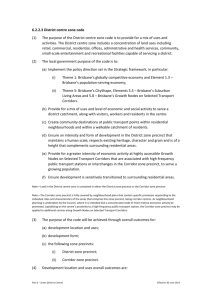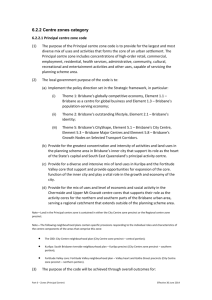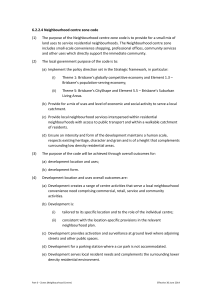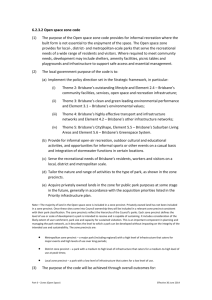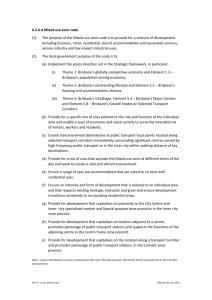Major centre zone code
advertisement
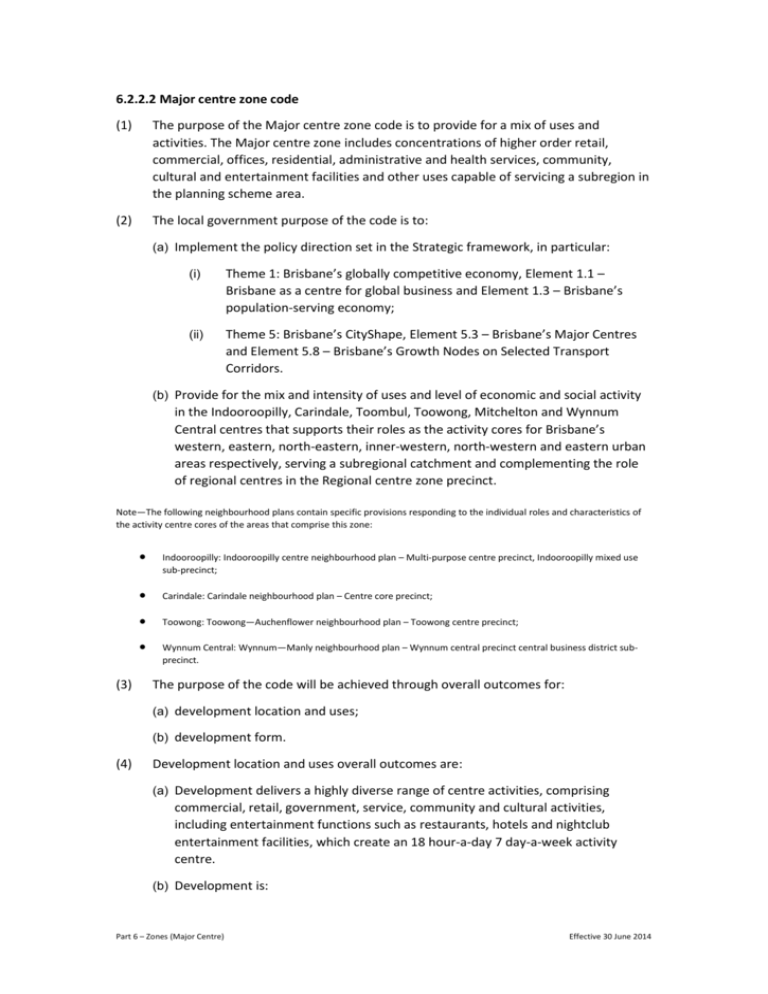
6.2.2.2 Major centre zone code (1) The purpose of the Major centre zone code is to provide for a mix of uses and activities. The Major centre zone includes concentrations of higher order retail, commercial, offices, residential, administrative and health services, community, cultural and entertainment facilities and other uses capable of servicing a subregion in the planning scheme area. (2) The local government purpose of the code is to: (a) Implement the policy direction set in the Strategic framework, in particular: (i) Theme 1: Brisbane’s globally competitive economy, Element 1.1 – Brisbane as a centre for global business and Element 1.3 – Brisbane’s population-serving economy; (ii) Theme 5: Brisbane’s CityShape, Element 5.3 – Brisbane’s Major Centres and Element 5.8 – Brisbane’s Growth Nodes on Selected Transport Corridors. (b) Provide for the mix and intensity of uses and level of economic and social activity in the Indooroopilly, Carindale, Toombul, Toowong, Mitchelton and Wynnum Central centres that supports their roles as the activity cores for Brisbane’s western, eastern, north-eastern, inner-western, north-western and eastern urban areas respectively, serving a subregional catchment and complementing the role of regional centres in the Regional centre zone precinct. Note—The following neighbourhood plans contain specific provisions responding to the individual roles and characteristics of the activity centre cores of the areas that comprise this zone: Carindale: Carindale neighbourhood plan – Centre core precinct; Toowong: Toowong—Auchenflower neighbourhood plan – Toowong centre precinct; (3) Indooroopilly: Indooroopilly centre neighbourhood plan – Multi-purpose centre precinct, Indooroopilly mixed use sub-precinct; Wynnum Central: Wynnum—Manly neighbourhood plan – Wynnum central precinct central business district subprecinct. The purpose of the code will be achieved through overall outcomes for: (a) development location and uses; (b) development form. (4) Development location and uses overall outcomes are: (a) Development delivers a highly diverse range of centre activities, comprising commercial, retail, government, service, community and cultural activities, including entertainment functions such as restaurants, hotels and nightclub entertainment facilities, which create an 18 hour-a-day 7 day-a-week activity centre. (b) Development is: Part 6 – Zones (Major Centre) Effective 30 June 2014 (i) tailored to its specific location and to the role of the individual centre; (ii) consistent with the location-specific provisions in the relevant neighbourhood plan. (c) Development for a parking station where a car park is not accommodated. (d) Development provides for high-order retail activities and commercial activities that create a focus point for subregional employment and district or branch government functions including health, education and cultural services. (e) Development for a residential use: (i) is high density; (ii) does not compromise the primary function of the Major centre zone as a commercial activity centre; (iii) facilitates urban consolidation and the efficient use of physical and social infrastructure; (iv) supports the creation of a walkable centre with the potential for residents to live within walking distance of and be well connected to high-frequency public transport, employment, entertainment and community facilities existing within the centre and reduces vehicle-based trips to work, shops or centres; (v) provides a wide choice in housing sizes and housing adaptability that meet the needs of a diverse population and respond to residents' lifecycle needs; (vi) may include a home based business where it is of a scale and nature that protects the amenity of adjoining residents. (f) Development for residential accommodation such as rooming accommodation, a residential care facility and a retirement facility may be suitable where it is high density and consistent with the urban form and primary functions of the centre. (g) Development is designed, sited and constructed to minimise noise, odour and air- quality impacts on residents consistent with its location in the Major centre zone, although residents cannot expect to enjoy the same level of noise, odour and airquality amenity as low density suburban areas (due to the high levels of activity envisaged during the day, evening and night). (h) Development for a car wash or service station is carefully sited and designed to minimise any adverse impacts on the vibrancy of the centre and to protect surrounding residential amenity. (i) Development for uses that are often provided in a large-scale format such as hardware and trade supplies, garden centre or showroom: (i) is limited in area and frontage; (ii) provides the level of activation and interface with the street expected of other non-residential uses in the Major centre zone. Part 6 – Zones (Major Centre) Effective 30 June 2014 (5) Development form overall outcomes are: (a) Development is of a height, bulk, scale and form which is tailored to its specific location and to the characteristics of the site and the centre including: (i) the location of existing buildings, specialist uses and public transport interchanges; (ii) access arrangements; (iii) the location of and connections to active transport networks; (iv) the shape, frontage, size, orientation and slope of the site; (v) local neighbourhood identity, topography and views; (vi) the mix of surrounding uses; (vii) the location of surrounding heritage places, parks and environmental features. (b) Development capitalises on the centre's proximity to high-frequency suburban or inter-urban public transport networks. (c) Development provides public spaces and landscaping, including deep planting, that soften the dominance of buildings, provide breathing space and encourage outdoor activity integrated with the surrounding area and enable fine-grained pedestrian connectivity through the centre. (d) Development for a building addresses and interfaces with the street and other adjoining public spaces including via active uses at ground level (with parking located below buildings) to ensure highly active streets and to provide surveillance of the public domain. (e) Development is integrated and coordinated both within the site and in relation to surrounding land uses. (f) Development reinforces a highly accessible centre that has direct access to high- frequency public transport corridors with key suburban or inter-urban connections and to active transport links and infrastructure that provide viable modal choice to centre users. (g) Development provides vehicular access arrangements that minimise impacts on surrounding land and protect the functionality of both local and higher order road networks. (h) Development creates an activated public domain both internally and at the centre edges, with intensive and interactive outward-looking uses at ground level that maintain visual connection and physical integration with surrounding land uses. (i) Development provides clear, direct, safe and comfortable internal connectivity for pedestrians to key destinations throughout the centre, including to public transport services and active transport links, public spaces and connection points with surrounding land uses. Part 6 – Zones (Major Centre) Effective 30 June 2014 (j) Development is sensitively designed and operated to avoid or mitigate any potential adverse impacts on an adjoining use. (k) Development responds to land constraints, mitigates any adverse impacts on environmental values and addresses other specific characteristics, as identified by overlays affecting the site or in codes applicable to the development. Part 6 – Zones (Major Centre) Effective 30 June 2014

